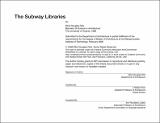The subway libraries
Author(s)
Felix, Elliot Douglas
DownloadFull printable version (10.27Mb)
Other Contributors
Massachusetts Institute of Technology. Dept. of Architecture.
Advisor
J. Meejin Yoon.
Terms of use
Metadata
Show full item recordAbstract
As New York' subway has adapted to changes in population, routing, and technology, numerous platforms have been abandoned - left as vestigial spaces within functioning stations. Despite their disuse, these spaces have enormous latent potential. This project couples two circulatory infrastructures in the city, public libraries and public transit, to reclaim three such platforms as sites for a new institution -- the Open Library. This institution seeks to extend the historical development of the library with a greater focus on access, knowledge production, and user-agency while also acknowledging the mobility inherent in the modern city and providing opportunities for interaction and circulation among people and artifacts. Located on abandoned platforms at Columbus Circle, Canal Street, and Brooklyn Bridge Stations, these libraries are designed such that the space of the library functions as a diagram of the institution. Each is an open, linear space formed between walls which function as reinvented stacks. Rather than a container designed solely according to the program of the book, here, each stack pairs a glass wall toward the subway with a wood wall facing the library while varying the character and separation of the pair according to the library's numerous programs -- sometimes only wide enough for books and acoustic baffling while at other times bulging to accommodate an entire room or a sky-lit planter. The result is a series of interventions within the subway that questions the relationship between knowledge production and consumption, provides places of interaction among people and artifacts, and instigates a physical and intellectual renovation of both subway and library.
Description
Thesis (M. Arch.)--Massachusetts Institute of Technology, Dept. of Architecture, 2006. This electronic version was submitted by the student author. The certified thesis is available in the Institute Archives and Special Collections. Includes bibliographical references (p. 173-177).
Date issued
2006Department
Massachusetts Institute of Technology. Department of ArchitecturePublisher
Massachusetts Institute of Technology
Keywords
Architecture.